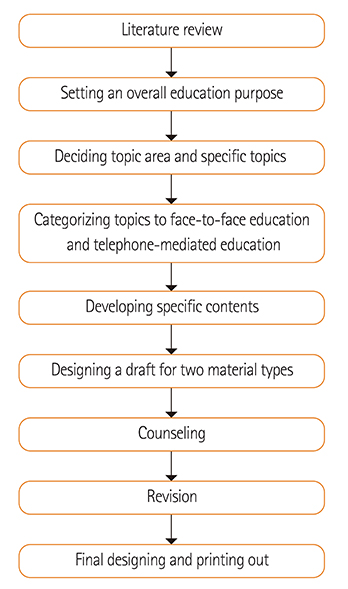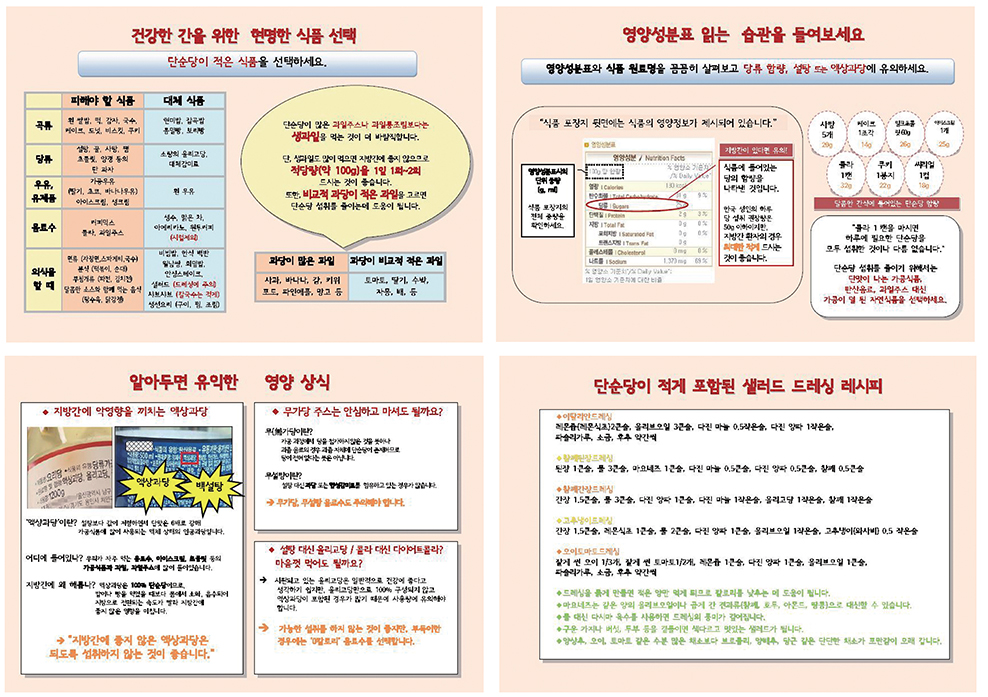Clin Nutr Res.
2015 Oct;4(4):250-258. 10.7762/cnr.2015.4.4.250.
Development and Application of Low-Carbohydrates and Low-Simple Sugar Nutrition Education Materials for Non-Alcoholic Fatty Liver Disease Patients
- Affiliations
-
- 1Department of Food and Nutrition, Sungshin Women's University, Seoul 01133, Korea. smlee@sungshin.ac.kr
- 2Department of Internal Medicine, Hanyang University College of Medicine, Seoul 04763, Korea.
- KMID: 2386082
- DOI: http://doi.org/10.7762/cnr.2015.4.4.250
Abstract
- We developed nutrition education materials for non-alcoholic fatty liver disease (NAFLD) patients focusing on low-carbohydrate and low-simple sugar diet and assessed subjective difficulty and compliance for the developed materials. The materials were developed in 2 types, a booklet for face-to-face education and a handout for phone education. The booklet covered 4 topic areas of fatty liver, low-carbohydrate and low-simple sugar diet, weight control, and meal plan. The handout material included several eating behavior tips. To assess practical usability of nutrition education using the developed materials, subjective compliance and difficulty levels were examined in a sample for NAFLD patients. A total of 106 patients recruited from 5 general hospitals were randomly assigned to a low-carbohydrate and low-simple sugar weight control diet group or a general weight control diet group. Each participant received a 6-week nutrition education program consisting of a face-to-face education session and two sessions of phone education. The developed materials were used for the low-carbohydrate and low-simple sugar weight control diet group and general weight control information materials were used for the control group. Subjective difficulty and compliance levels were evaluated three times during the education period. Subjective difficulty level was significantly higher in the low-carbohydrate and low-simple sugar diet group compared to the control group at the end of the second week, but such a discrepancy disappeared afterward. No significant difference was found for subjective compliance between the groups at each time. In conclusion, the developed nutrition education materials for low-carbohydrate and low-simple sugar diet are reasonably applicable to general Korean NAFLD patients.
MeSH Terms
Figure
Reference
-
1. Becker U, Deis A, Sørensen TI, Grønbaek M, Borch-Johnsen K, Müller CF, Schnohr P, Jensen G. Prediction of risk of liver disease by alcohol intake, sex, and age: a prospective population study. Hepatology. 1996; 23:1025–1029.
Article2. Clark JM. The epidemiology of nonalcoholic fatty liver disease in adults. J Clin Gastroenterol. 2006; 40:Suppl 1. S5–S10.3. Ministry of Health and Welfare, Korea Centers for Disease Control and Prevention. Metabolic syndrome prevalence among Korean adults aged 30 years and older: based on 2007-2010 Korean National Health and Nutrition Examination Survey. Cheongwon: Korea Centers for Disease Control and Prevention;2012.4. Jeong EH, Jun DW, Cho YK, Choe YG, Ryu S, Lee SM, Jang EC. Regional prevalence of non-alcoholic fatty liver disease in Seoul and Gyeonggi-do, Korea. Clin Mol Hepatol. 2013; 19:266–272.
Article5. Bedogni G, Miglioli L, Masutti F, Tiribelli C, Marchesini G, Bellentani S. Prevalence of and risk factors for nonalcoholic fatty liver disease: the Dionysos nutrition and liver study. Hepatology. 2005; 42:44–52.
Article6. Day CP, James OF. Steatohepatitis: a tale of two "hits"? Gastroenterology. 1998; 114:842–845.
Article7. Lewis JR, Mohanty SR. Nonalcoholic fatty liver disease: a review and update. Dig Dis Sci. 2010; 55:560–578.
Article8. Bellentani S, Scaglioni F, Marino M, Bedogni G. Epidemiology of non-alcoholic fatty liver disease. Dig Dis. 2010; 28:155–161.
Article9. Petersen KF, Dufour S, Feng J, Befroy D, Dziura J, Dalla Man C, Cobelli C, Shulman GI. Increased prevalence of insulin resistance and nonalcoholic fatty liver disease in Asian-Indian men. Proc Natl Acad Sci U S A. 2006; 103:18273–18277.
Article10. Deurenberg P, Deurenberg-Yap M, Guricci S. Asians are different from Caucasians and from each other in their body mass index/body fat per cent relationship. Obes Rev. 2002; 3:141–146.
Article11. Petersen KF, Dufour S, Befroy D, Lehrke M, Hendler RE, Shulman GI. Reversal of nonalcoholic hepatic steatosis, hepatic insulin resistance, and hyperglycemia by moderate weight reduction in patients with type 2 diabetes. Diabetes. 2005; 54:603–608.
Article12. Huang MA, Greenson JK, Chao C, Anderson L, Peterman D, Jacobson J, Emick D, Lok AS, Conjeevaram HS. One-year intense nutritional counseling results in histological improvement in patients with non-alcoholic steatohepatitis: a pilot study. Am J Gastroenterol. 2005; 100:1072–1081.
Article13. Sanyal AJ. AGA technical review on nonalcoholic fatty liver disease. Gastroenterology. 2002; 123:1705–1725.
Article14. Andersen T, Gluud C, Franzmann MB, Christoffersen P. Hepatic effects of dietary weight loss in morbidly obese subjects. J Hepatol. 1991; 12:224–229.
Article15. Westerbacka J, Lammi K, Häkkinen AM, Rissanen A, Salminen I, Aro A, Yki-Järvinen H. Dietary fat content modifies liver fat in overweight nondiabetic subjects. J Clin Endocrinol Metab. 2005; 90:2804–2809.
Article16. Machado MV, Ravasco P, Jesus L, Marques-Vidal P, Oliveira CR, Proença T, Baldeiras I, Camilo ME, Cortez-Pinto H. Blood oxidative stress markers in non-alcoholic steatohepatitis and how it correlates with diet. Scand J Gastroenterol. 2008; 43:95–102.
Article17. Schwarz JM, Neese RA, Turner S, Dare D, Hellerstein MK. Short-term alterations in carbohydrate energy intake in humans. Striking effects on hepatic glucose production, de novo lipogenesis, lipolysis, and wholebody fuel selection. J Clin Invest. 1995; 96:2735–2743.
Article18. Kang H, Greenson JK, Omo JT, Chao C, Peterman D, Anderson L, Foess-Wood L, Sherbondy MA, Conjeevaram HS. Metabolic syndrome is associated with greater histologic severity, higher carbohydrate, and lower fat diet in patients with NAFLD. Am J Gastroenterol. 2006; 101:2247–2253.
Article19. Kwon OW, Jun DW, Lee SM, Lee KN, Lee HL, Lee OY, Yoon BC, Choi HS. Carbohydrate but not fat is associated with elevated aminotransferases. Aliment Pharmacol Ther. 2012; 35:1064–1072.
Article20. Benjaminov O, Beglaibter N, Gindy L, Spivak H, Singer P, Wienberg M, Stark A, Rubin M. The effect of a low-carbohydrate diet on the nonalcoholic fatty liver in morbidly obese patients before bariatric surgery. Surg Endosc. 2007; 21:1423–1427.
Article21. Haufe S, Engeli S, Kast P, Böhnke J, Utz W, Haas V, Hermsdorf M, Mahler A, Wiesner S, Birkenfeld AL, Sell H, Otto C, Mehling H, Luft FC, Eckel J, Schulz-Menger J, Boschmann M, Jordan J. Randomized comparison of reduced fat and reduced carbohydrate hypocaloric diets on intrahepatic fat in overweight and obese human subjects. Hepatology. 2011; 53:1504–1514.
Article22. Solga S, Alkhuraishe AR, Clark JM, Torbenson M, Greenwald A, Diehl AM, Magnuson T. Dietary composition and nonalcoholic fatty liver disease. Dig Dis Sci. 2004; 49:1578–1583.
Article23. Samaha FF, Iqbal N, Seshadri P, Chicano KL, Daily DA, McGrory J, Williams T, Williams M, Gracely EJ, Stern L. A low-carbohydrate as compared with a low-fat diet in severe obesity. N Engl J Med. 2003; 348:2074–2081.
Article24. Ebbeling CB, Leidig MM, Feldman HA, Lovesky MM, Ludwig DS. Effects of a low-glycemic load vs low-fat diet in obese young adults: a randomized trial. JAMA. 2007; 297:2092–2102.
Article25. Hession M, Rolland C, Kulkarni U, Wise A, Broom J. Systematic review of randomized controlled trials of low-carbohydrate vs low-fat/low-calorie diets in the management of obesity and its comorbidities. Obes Rev. 2009; 10:36–50.
Article26. Lim JS, Mietus-Snyder M, Valente A, Schwarz JM, Lustig RH. The role of fructose in the pathogenesis of NAFLD and the metabolic syndrome. Nat Rev Gastroenterol Hepatol. 2010; 7:251–264.
Article27. Bergheim I, Weber S, Vos M, Krämer S, Volynets V, Kaserouni S, McClain CJ, Bischoff SC. Antibiotics protect against fructose-induced hepatic lipid accumulation in mice: role of endotoxin. J Hepatol. 2008; 48:983–992.
Article28. Abid A, Taha O, Nseir W, Farah R, Grosovski M, Assy N. Soft drink consumption is associated with fatty liver disease independent of metabolic syndrome. J Hepatol. 2009; 51:918–924.
Article29. Abdelmalek MF, Suzuki A, Guy C, Unalp-Arida A, Colvin R, Johnson RJ, Diehl AM. Nonalcoholic Steatohepatitis Clinical Research Network. Increased fructose consumption is associated with fibrosis severity in patients with nonalcoholic fatty liver disease. Hepatology. 2010; 51:1961–1971.
Article30. Ministry of Health and Welfare, Korea Centers for Disease Control and Prevention. Korea Health Statistics 2012: Korea National Health and Nutrition Examination Survey (KNHANES V-3). Cheongwon: Korea Centers for Disease Control and Prevention;2013.31. Wright JD, Wang CY. Trends in intake of energy and macronutrients in adults from 1999-2000 through 2007-2008: NCHS data brief no. 49. Hyattsville (MD): U.S. Department of Health and Human Services, Centers for Disease Control and Prevention, National Center for Health Statistics;2010.32. Rotman Y, Koh C, Zmuda JM, Kleiner DE, Liang TJ. NASH CRN. The association of genetic variability in patatin-like phospholipase domaincontaining protein 3 (PNPLA3) with histological severity of nonalcoholic fatty liver disease. Hepatology. 2010; 52:894–903.
Article33. Lee HJ. Effect of individual health education the medical clinic of public health centers on knowledge, self-efficacy, and self-care behavior in clients with hypertension [master's thesis]. Seoul: Yonsei University;2003.34. Choi JC. An analysis of effects of intervention methods for community-based prevention of cardiovascular diseases [Ph.D. thesis]. Gimhae: Inje University;2005.35. Ju K, So H. Effects of the nutrition education program on self-efficacy, diet behavior pattern and cardiovascular risk factors for the patients with cardiovascular disease. J Korean Acad Nurs. 2008; 38:64–73.
Article36. Hong SM, Kim HJ. A study of calcium status and effect of nutrition education of prevention osteoporosis in middle-aged women. J Korean Diet Assoc. 2001; 7:159–166.37. Kim TY, Um SH. Older adults with type 2 diabetes improve glycemic control after nutritional education program at the public health center. J Korean Diet Assoc. 2004; 10:205–217.38. Kim S, Sohn C, Chung WY. Effects of medical nutrition therapy on food habits and serum lipid levels of hypercholesterolemic patients. J Korean Diet Assoc. 2005; 11:125–132.39. Korean Association for the Study of the Liver. Clinical practice guidelines for non-alcoholic fatty liver disease. Seoul: Korean Association for the Study of the Liver;2013.40. Joo DR. Dietary therapy for non-alcoholic fatty liver disease and obesity. Clin Mol Hepatol. 2008; 14:s61–s72.41. Lee YM. Practical use of media for nutrition education. Korean J Nutr. 2000; 33:923–939.42. The Korean Nutrition Society. Dietary reference intakes for Koreans. 1st rev. Seoul: The Korean Nutrition Society;2010.43. United States Department of Agriculture, Agricultural Research Service. National nutrient database for standard reference, release 26 [Internet]. 2012. cited 2012 April 1. Available from http://ndb.nal.usda.gov/ndb/search/list.44. Ministry of Food and Drug Safety (KR). Reduction of simple sugar content [Internet]. 2010. cited 2012 April 1. Available from http://www.mfds.go.kr/nutrition/index.do?nMenuCode=29.45. Jun DW. Practice guideline for the diagnosis and management of nonalcoholic fatty liver disease. Korean J Gastroenterol. 2012; 60:64–66.
Article46. Contento I, Balch GI, Bronner YL, Lytle LA, Maloney SK, Olson CM, Swadener SS. The effectiveness of nutrition education and implications for nutrition education policy, programs, and research: a review of research. J Nutr Educ. 1995; 27:277–418.47. Eyles HC, Mhurchu CN. Does tailoring make a difference? A systematic review of the long-term effectiveness of tailored nutrition education for adults. Nutr Rev. 2009; 67:464–480.
Article48. Alhassan S, Kim S, Bersamin A, King AC, Gardner CD. Dietary adherence and weight loss success among overweight women: results from the A to Z weight loss study. Int J Obes (Lond). 2008; 32:985–991.
Article49. Shikany JM, Margolis KL, Pettinger M, Jackson RD, Limacher MC, Liu S, Phillips LS, Tinker LF. Effects of a low-fat dietary intervention on glucose, insulin, and insulin resistance in the Women's Health Initiative (WHI) dietary modification trial. Am J Clin Nutr. 2011; 94:75–85.
Article50. McClain AD, Otten JJ, Hekler EB, Gardner CD. Adherence to a low-fat vs. low-carbohydrate diet differs by insulin resistance status. Diabetes Obes Metab. 2013; 15:87–90.
Article
- Full Text Links
- Actions
-
Cited
- CITED
-
- Close
- Share
- Similar articles
-
- The Role of Diet in Non-alcoholic Fatty Liver Disease
- Should you advocate for hepatocellular carcinomasurveillance in patients with alcohol-related liverdisease or non-alcoholic fatty liver disease?
- The Effect of Nutrition Education Program on Overweight/Obese Patients with Non-Alcoholic Fatty Liver Disease: a Single-Blind Parallel Randomized Controlled Trial
- Gut Microbiota and Clinical Disease: Obesity and Nonalcoholic Fatty Liver Disease
- Cardiovascular Risk in Patients with Non-alcoholic Fatty Liver Disease






